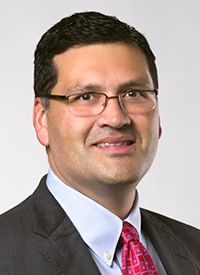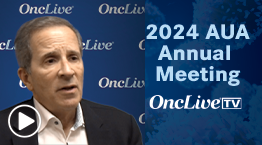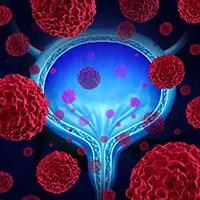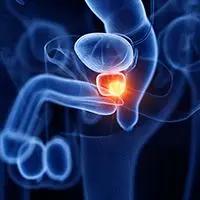BCMA-Directed Therapies Broaden Myeloma Arsenal and Could Reshape Earlier Lines of Treatment
Jesus Berdeja, MD, discussed considerations when choosing between bispecific antibodies and CAR T-cell therapy for patients with multiple myeloma, clinical trials that may move CAR T-cell therapy into earlier lines, and research with agents directed at targets other than BCMA.
Jesus Berdeja, MD

Although several BCMA-targeting bispecific antibodies and CAR T-cell therapies are approved for patients with multiple myeloma, determining which agent is optimal for an individual patient depends on factors including patient characteristics and the pace of disease progression, according to Jesus Berdeja, MD, who emphasized that several questions remain unanswered in this area.
Additionally, Berdeja noted the potential for CAR T-cell therapies to move into earlier lines of therapy, which findings from the phase 3 KarMMa-3 (NCT03651128) and CARTITUDE-4 (NCT04181827) trials support. In KarMMa-3, idecabtagene vicleucel (ide-cel; Abecma) generated a median progression-free survival (PFS) of 13.3 months (95% CI, 11.8-16.1) vs 4.4 months (95% CI, 3.4-5.9) with standard of care (SOC) in patients with relapsed/refractory multiple myeloma who had received between 2 and 4 prior lines of therapy (HR, 0.49; 95% CI, 0.38-0.65; 2-sided P < .001).1 In CARTITUDE-4, the median PFS with ciltacabtagene autoleucel (cilta-cel; Carvykti) was not reached vs 11.8 months with SOC (HR, 0.26; 95% CI, 0.18-0.38; P < .001) in patients with lenalidomide (Revlimid)-refractory multiple myeloma.2
“It’s exciting times in myeloma, and we keep moving the needle forward. Hopefully, we’re on the cusp of curing, if not all, then at least a subset of our patients,” Berdeja said in an interview with OncLive®.
In the interview, Berdeja, who is the director of Multiple Myeloma Research at Tennessee Oncology in Nashville, discussed considerations when choosing between bispecific antibodies and CAR T-cell therapy for patients with multiple myeloma, clinical trials that may move CAR T-cell therapy into earlier lines, and research with agents directed at targets other than BCMA.
OncLive: How do BCMA-directed therapies currently fit into the multiple myeloma treatment armamentarium?
Berdeja: BCMA-directed therapies are the next pillar of therapies in myeloma. Immunomodulatory agents [IMiDs], proteasome inhibitors [PIs], and anti-CD38 antibodies are the backbone of therapy. However, once patients have exhausted or been exposed to those 3 classes, the BCMA-directed therapies are coming to the forefront in terms of efficacy in the next line.
Currently, we have 4 FDA-approved products that target BCMA: 2 CAR T-cell therapies, ide-cel and cilta-cel, and 2 bispecific antibodies, teclistamab-cqyv [Tecvayli] and elranatamab-bcmm [Elrexfio]. These 4 drugs have the same indication from the FDA in the United States: Patients need to have 4-plus [prior] lines of therapy and prior [treatment with a] PI, IMiD, and anti-CD38 [antibody]. These treatments are now available to patients, and we’re all trying to figure out how to best use them, whether there’s a particular sequence we need to [use], etc.
What factors do you consider when choosing between CAR T-cell therapy and bispecific antibodies in this setting?
That’s an excellent question, and one we’re all still trying to figure out. These [BMCA-directed agents] are all new therapies, and a lot of the pivotal studies for these [agents] excluded patients who had received prior BCMA-directed therapies, so we don’t have those direct data. We are looking at real-world evidence and newer studies that allow [patients with] prior BCMA-directed therapy to give us clues into what may be the best ways to sequence these. However, at the end of the day, a lot of [this decision making] has to do with patient characteristics, the patient’s pace of disease, and the availability of therapies.
CAR T-cell therapy is probably the more difficult [option to use]. It requires quite a bit of planning. It requires the collection of T cells and then the subsequent manufacturing of CAR T cells. That turnaround time is usually approximately 4 to 6 weeks. In a patient with rapidly progressive disease, it is imperative that there is a bridging therapy, meaning a treatment that can control that disease, to allow that patient to stay well until CAR T-cell therapy [can be manufactured and administered]. A patient who is refractory and has a high burden of disease that is moving quickly may not be the optimal patient for CAR T-cell therapy, simply because of the logistics.
Bispecific antibodies, on the other hand, are off the shelf; they’re available like any other drug. They can be prescribed as soon as [a patient gets] insurance approval, and [patients can quickly] start the treatment. Perhaps in a patient who has the characteristics I just mentioned, a bispecific antibody may be preferable.
Regarding the type of patient that one would consider for either treatment, there is no specific characteristic that favors 1 [class of drug] over the other. Age alone is not a reason to not consider a CAR T-cell therapy. A lot of people think of CAR T-cell therapy as an aggressive therapy that maybe we shouldn’t use in elderly [patients]. However, good data show that the older patients in different [CAR T-cell therapy] trials fared just as well [as younger patients] and, [similar to the younger patients], had no increased toxicity with CAR T-cell therapy. Age alone is not a reason to exclude [patients] from CAR T-cell therapy.
However, a frailer patient or a patient with significant comorbidities that may make it more dangerous for them to withstand cytokine release syndrome and the extensive cytopenias that can result with CAR T-cell therapy may [have better outcomes] with a bispecific antibody.
What is your advice for colleagues regarding treatment sequencing with bispecific antibodies and CAR T-cell therapies?
The early data we have imply that patients who had good responses to prior BCMA-directed CAR T-cell therapy and subsequently relapsed appear to respond well to bispecific antibodies. Perhaps the opposite is not true. In patients who are relapsing on bispecific antibodies and go on to receive CAR T-cell therapy, the CAR T-cell therapy is not as efficacious, and the duration of response [DOR] tends to be much shorter. If the patient is eligible for all classes of therapy, CAR T-cell therapy should be given first and the bispecific antibody should be reserved, if appropriate.
What research and regulatory action is needed to move CAR T-cell therapy into earlier lines in multiple myeloma?
Research is already ongoing. The current indication for CAR T-cell therapy is [for patients with] 4-plus lines of therapy. However, 2 randomized phase 3 trials, KarMMa-3 and CARTITUDE-4, evaluating ide-cel and cilta-cel, [respectively], in earlier lines of therapy, showed that CAR T-cell therapy is superior to SOC. KarMMa-3 [enrolled] patients with 2 to 4 prior lines of therapy, most of whom had been exposed [to an anti-CD38 antibody]. CARTITUDE-4 [enrolled] patients with 1 to 3 prior lines of therapy, [of whom] only 25.5% [in the cilta-cel arm] had prior anti-CD38 exposure. Both [trials] showed superiority of the CAR T-cell therapies over SOC.
We expect the FDA to move [ide-cel and cilta-cel] earlier in the course of therapy, perhaps as early as [the end of 2023]. It’s unclear, though, what the indication will be. [The FDA] may get rid of the lines of therapy and just allow a patient who has had a prior PI, IMiD, and anti-CD38 antibody to receive a CAR T-cell therapy. That’s exciting because a lot of patients ask [about CAR T-cell therapy], and getting them through 4 lines of therapy before CAR T-cell therapy, or 4 lines of therapy that are superior to CAR T-cell therapy, is difficult. [Those expanded approvals would] help us quite a bit.
Ongoing research is investigating the incorporation of both CAR T-cell therapies and bispecific antibodies into the frontline setting [for patients with] myeloma. This is still early research, and we don’t expect the results for another 2 years or so. However, the population that’s being evaluated is high-risk patients with myeloma who do not do well with standard therapies. [They have] an unmet need. Research is ongoing to try to move these powerful therapies earlier in the course. Some randomized phase 3 trials are also starting to investigate [CAR T-cell therapy in] both transplant-eligible and -ineligible patients. It’s possible that in the next 5 years, we will see these therapies move to the frontline setting.
What multiple myeloma research are you involved in at Tennessee Oncology?
We have a lot of exciting research going on. [Beyond BCMA], there are other targets in myeloma. Probably the most salient one is GPRC5D. A bispecific antibody, talquetamab-tgvs [Talvey], is now approved, [and this agent targets] GPRC5D instead of BCMA. Subsequently, we have research with a CAR T-cell therapy that targets GPRC5D. That [trial] allows patients who have had prior BCMA-directed therapy, including prior BCMA-directed CAR T-cell therapies and bispecific antibodies. The interim results have been reported are impressive. We’re hoping that soon we will have a CAR T-cell therapy that will complement the current armamentarium.
Other bispecific antibodies [directed at] another protein called FcRH5 are also generating impressive results. Additionally, combination trials with all the different bispecific antibodies plus other antimyeloma therapies, such as anti-CD38 antibodies and cereblon modulators, are hoping to improve upon the current responses and DORs [observed with standard therapies]. Those are all ongoing. We also have some research combining bispecific antibodies in patients with extramedullary disease, [who represent a population with a high unmet need]. A lot of exciting [developments are happening] with both currently available therapies in combinations and new therapies that are not yet available commercially.
What is your main message for colleagues regarding the current role of BCMA-targeted therapies in the multiple myeloma treatment paradigm?
BCMA-directed therapies should [eventually] be [moved up to] the frontline setting. They are complex therapies, so if you don’t have experience with them, they require [you to] partner with someone who does to help with the process. The response rates and DORs we’re seeing with these therapies are superior to any [outcomes with the other therapies] we have in the relapsed/refractory setting. I would encourage people to try to get their [appropriate] patients to these therapies.
References
- Rodriguez-Otero P, Ailawadhi S, Arnulf B, et al. Ide-cel or standard regimens in relapsed and refractory multiple myeloma. N Engl J Med. 2023;388(11):1002-1014. doi:10.1056/NEJMoa2213614
- San-Miguel J, Dhakal B, Yong K, et al. Cilta-cel or standard care in lenalidomide-refractory multiple myeloma. N Engl J Med. 2023;389(4):335-347. doi:10.1056/NEJMoa2303379



